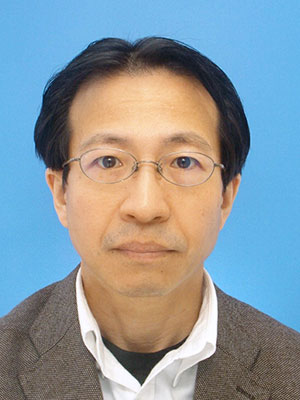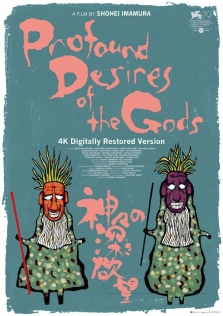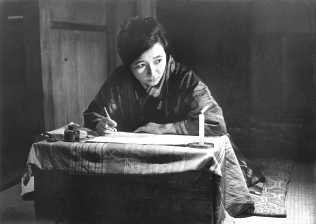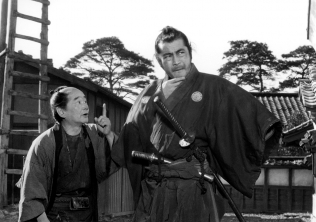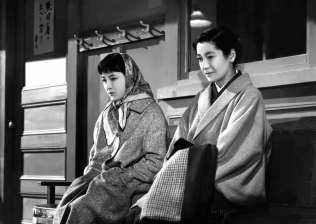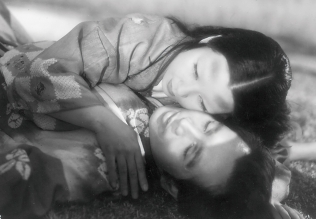An introduction to the “Big Five” system that defined the pre- and postwar Japanese film industry landscape
Like the so-called “Big Five” that dominated its Hollywood counterpart, the story of Japan’s studio system too centers on the exploits of five major film companies. Yet it wouldn’t be until after the war that the line-up of five became consolidated as such, with the first golden age of Japanese cinema, that of the 1930s, having been the product of a slightly different set of main players.
Of the studios that would go on to comprise Japan’s own “Big Five,” Nikkatsu was the oldest. Founded in 1912 at a time when Hollywood wasn’t yet the center of American film production, Nikkatsu’s first forays into motion pictures reflected the Japan of its time, torn between the poles of tradition and modernization. Representing tradition was the studio’s prolific output of kyugeki (literally, “old theater”) titles: period pieces that heavily retained the traditions of kabuki, brought to life by the immensely popular star ONOE Matsunosuke. At the same time, the studio also gained popularity with modern melodramas known as shinpa (“new-school”) tragedies, for which it constructed a glass stage in its Mukojima studio that was to become a symbol of the modernity of this new, cutting-edge medium. (It was Nikkatsu’s Mukojima studio, on the east side of Tokyo, where many of Japan’s future leading directors would learn their trade, including MIZOGUCHI Kenji.) Nikkatsu was also the first studio to use female actors, doing away with the kabuki practice of onnagata whereby male actors traditionally played female roles.
In 1920, Shochiku, an entertainment company that had made its name producing kabuki plays, entered the film industry. Shochiku was notable for training its actors under the principles of shingeki (“new theater”), a modern theater movement centered on the production of foreign plays in translation, as well as for the degree of freedom it granted its directors, thus playing a crucial role in the modernizing of Japanese cinema. Its specialty was the shoshimin-eiga (“petit-bourgeoisie film”), which depicted with humor and pathos the daily lives of the newly emerging white-collar, urban lower-middle class. The films’ signature identity came to be known as Kamata-style (later Ofuna-style) after the location of the studios where they were shot. It was a style and tradition to which OZU Yasujiro, who remained with Shochiku throughout his career, would stay true to the very end.
It was Shochiku, too, who first made the leap from the old drama of the kyugeki to the newer form of the jidaigeki-eiga: “period-drama films” infused with a level of realism that had been missing from the more traditional, kabuki-based style. The key player behind this reform was screenwriter ITO Daisuke. Upon becoming a director at Nikkatsu in the late 1920s, Ito would produce a string of virile works bursting with tragic beauty, such as Diary of Chuji’s Travels (Chuji tabi nikki, 1927), which incorporated influences from European avant-garde cinema and elevated the period drama to the realm of art. Indeed, it was on the back of Ito’s having already achieved sublimity with the period-drama form that gifted directors like YAMANAKA Sadao were able to modernize it in the 1930s, infusing the Nikkatsu jidaigeki with a more cheerful, vibrant breath of life.
That Shochiku was the first Japanese studio to make the transition to talkies (which demanded a substantial investment in equipment) is perhaps not surprising. Yet the most notable development in 1930s’ Japanese cinema was the rise to prominence of Toho, a company that had initially made its name renting its own sound stages to other production companies during the silent-to-talkie transition (the studio began film production in 1933 as P.C.L., an abbreviation of Photo Chemical Laboratories, before changing its name to Toho in 1937). In contrast to the director system in favor at Shochiku at the time, Toho introduced a system centered around producers, following the Hollywood example of streamlining management and implementing tight budget control for each film. This rational, urban approach to management was also reflected in the studio’s films. Still a newcomer to the industry, Toho had to rely on actors associated with the shingeki movement – essentially the Japanese version of Western realist theater – which had the effect of promoting a more realistic acting style. It was arguably this new management style that gave NARUSE Mikio, who had struggled to gain attention at Shochiku, his chance to flourish, and led to the discovery of a young KUROSAWA Akira through the studio’s director recruitment program. At the same time, Toho was the happiest of all the major studios to comply with government pressure, becoming an active and prolific producer of wartime propaganda in the form of so-called kokusaku-eiga (“national-policy films”). Under the supervision of special effects director TSUBURAYA Eiji, films like The War at Sea from Hawaii to Malaya (Hawai mare oki kaisen, 1942) made effective use of elaborately crafted miniatures to stage battle scenes so realistic they were often mistaken for the real thing – a technique that Toho harnessed to stunning effect in its postwar special effects films beginning with Godzilla (Gojira) in 1954.
With the outbreak of the Pacific War, Japan’s film industry was accordingly reorganized and integrated into the wartime system. The merger of Nikkatsu with the newly formed Daiei in 1942 left three major studios – Shochiku, Toho, and Daiei – in charge of the country’s filmic output. After the war, as part of the Allied Occupation’s drive to hold the past regime responsible for its wartime conduct, many who had worked in the industry were driven from their posts, although the majority made their way back in just a few short years. That largely the same faces came to dominate Japan’s film industry after the war as before it, despite the country having suffered defeat, is a distinctive feature of Japan’s national film history. Most significant among the events triggered by Occupation policy was perhaps the Toho Labor Dispute, which eventually resulted in the formation of a new studio by the name of Shin-Toho (“New Toho”). Labor unions formed in response to the Allied Occupation’s democratic reforms had led a series of increasingly heated strike actions before eventually splintering; formed in 1947 by former union members hoping to prioritize filmmaking over politics, Shin-Toho made a name for itself in the ero-guro (erotic grotesque) genre over the 1950s, turning a paucity of star power and budget to its own advantage by developing a unique style that saw it become the sixth studio alongside the five majors.
The formation of the so-called “Big Five” was itself a development of the ‘50s. In 1951 came the founding of Toei, who over the next decade would revive production of the jidaigeki genre – effectively banned during the Occupation for being deemed inconsistent with the new democratic ideals – proving a massive hit with children and the public at large. Whereas at Shochiku and Toho it was respectively the director and producer who were afforded the greatest authority, Toei took a more novel star-centric approach – to the extent that when major stars appeared in the same movie as one another, careful consideration was given to ensure an equal distribution of close-ups. In Toei’s films of this era, innovation took a back seat to giving the audience more of what it had come to expect from them: namely, chambara narratives of good triumphing over evil, so named for their highly stylized, not to mention highly unrealistic, swordfight action sequences. As previously mentioned, it was Shochiku who first accomplished the transition to talkies, a feat it later repeated by producing Japan’s first color film as well; the fact that it was Toei who would pioneer widescreen speaks volumes about the changing power dynamics in the industry during this period.
With Nikkatsu’s eventual return to film production in 1954, the “Big Five” lineup was complete. Yet despite boasting the longest history of any of the studios, the Nikkatsu of the postwar period was forced to play catch-up. In an era when stars were tied by exclusive contracts to specific companies, Japan’s oldest studio had to turn to auditions to recruit the new talent it needed – a handicap that ironically enabled it to discover new stars, such as ISHIHARA Yujiro, who would go on to become synonymous with the post-war generation. Ishihara’s impressive physique, good upbringing, roguish charm, and Elvis good looks combined to create unprecedented sex appeal with which he captivated legions of female fans (many of Nikkatsu’s stars, including Ishihara, sang the theme songs to their own movies). Bolstered by this new generation of stars, Nikkatsu won popularity among young audiences with a steady stream of over-the-top action romps that played fast and loose with their Japan setting, lending them a distinctly international flavor. The studio also succeeded in recruiting many young directors from other studios who had yet to be given the chance to shine, the most notable examples being its transferees from Shochiku. It is difficult to overstress the fact that directors like KAWASHIMA Yuzo, IMAMURA Shohei, SUZUKI Seijun, and KUMASHIRO Tatsumi – figures who would go on to become some of Nikkatsu’s most renowned names – all originally learned their trade within Shochiku’s traditional system.
In 1958, under the dominance of the “Big Five,” Japanese film audiences reached an all-time high, marking a second golden age of Japanese cinema to stand alongside that of the ‘30s. It was a milestone that was also to signal the beginning of the end of the studio era. First among the studios to disappear was Shin-Toho, which had been plagued for years by chronic financial troubles. Even Shochiku, the most conservative of the companies, couldn’t prevent the emergence of a “new wave” from occurring within its own ranks. When avant-garde directors like OSHIMA Nagisa and YOSHIDA Kiju began rebelling against the Ofuna-style in both form and content, it caused conflict with the studio, leading to their eventually parting ways to pursue independent film production on their own terms.
Even the once hugely popular Toei jidaigeki could no longer hide its declining popularity. In the 1960s, Toei shifted its focus to yakuza films: tales in which “good” yakuza – the kind that valued giri (duty to society) and ninjo (duty to oneself) – were pitted against the “bad” kind, who colluded with modernization to trample violently over the old moral code. The plight of the former, faced with an enemy against whom they were all but guaranteed to lose, struck a chord with a generation of academic elites who were embroiled in their own struggles in the form of the 1960s student protest movement. Kurosawa’s jidaigeki of this period, such as the internationally acclaimed Yojimbo (1961), were but a mannerist twist on the more conventional form of a genre that was clearly on its way out. (Heavily inspired by the American Western, Kurosawa’s jidaigeki were in fact already “heretical” long before Sergio Leone returned the compliment by plagiarizing Yojimbo for his own A Fistful of Dollars [1964].) In the end, after being pushed out of the film industry, the jidaigeki would come to share its fate with the American Western, finding a new lease of life on the emerging medium of television.
Reflecting the then-prevailing public sense that all Japanese belonged to the middle class, Toho attempted to court the average cinemagoer with an output of urban “salaryman” comedies. These, together with the giant monster and war movies that capitalized on the studio’s expertise in special effects, proved cash cows for Toho, yet by themselves weren’t enough to halt the industry’s slow decline in profits. Daiei, meanwhile, emboldened by the international film festival success of Mizoguchi’s postwar jidaigeki in the ‘50s, continued in this vein, producing many sophisticated period pieces and adaptations of literary works. Quintessential examples were the films of MISUMI Kenji, who defied naturalistic editing conventions to produce jidaigeki with a severity and sharpness of tone; and MASUMURA Yasuzo who, railing against what he saw as Japanese tradition’s over-propensity for sentimentality, attempted to establish a more modern sensibility within the Japanese film landscape. Suffering from its own paucity of directly managed theaters, Daiei declared bankruptcy in 1971 – a year that also saw Nikkatsu change course to plunge headfirst into the world of softcore theatrical pornography with the launch of its new Roman Porno line (derived from the French term roman pornographique), a series that would eventually span a seventeen-year period and over 700 hundred films.
It may seem strange to talk about the end of the studio period given that four of the “Big Five” (the exception being Daiei) continue to produce films to this day; nonetheless, it is commonly accepted that this period marked the transition to the post-studio era. In 1973, Toei released Battles Without Honor and Humanity, a box-office hit that spawned a series and popularized the jitsuroku eiga (“reported reality film”) subgenre. As the film’s title suggests, it represented a complete repudiation of the chivalrous ideals of the ninkyo (“chivalry”) yakuza films that had once been the studio’s bread and butter. Rather aptly, it was also a fitting metaphor for the dog-eat-dog struggle that would play out haphazardly across the industry in the coming era, absent the unifying entities of old.
Translated by Adam Sutherland

